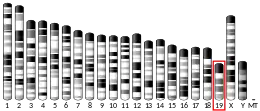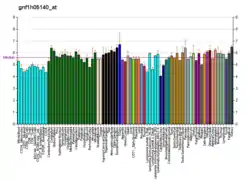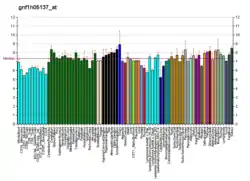| TMC1 | |||||||||||||||||||||||||||||||||||||||||||||||||||
|---|---|---|---|---|---|---|---|---|---|---|---|---|---|---|---|---|---|---|---|---|---|---|---|---|---|---|---|---|---|---|---|---|---|---|---|---|---|---|---|---|---|---|---|---|---|---|---|---|---|---|---|
| Identifiers | |||||||||||||||||||||||||||||||||||||||||||||||||||
| Aliases | TMC1, DFNA36, DFNB11, DFNB7, transmembrane channel like 1 | ||||||||||||||||||||||||||||||||||||||||||||||||||
| External IDs | OMIM: 606706 MGI: 2151016 HomoloGene: 23670 GeneCards: TMC1 | ||||||||||||||||||||||||||||||||||||||||||||||||||
| |||||||||||||||||||||||||||||||||||||||||||||||||||
| |||||||||||||||||||||||||||||||||||||||||||||||||||
| |||||||||||||||||||||||||||||||||||||||||||||||||||
| |||||||||||||||||||||||||||||||||||||||||||||||||||
| |||||||||||||||||||||||||||||||||||||||||||||||||||
| Wikidata | |||||||||||||||||||||||||||||||||||||||||||||||||||
| |||||||||||||||||||||||||||||||||||||||||||||||||||
Transmembrane channel-like protein 1 is a protein that in humans is encoded by the TMC1 gene.[5][6][7] TMC1 contains six transmembrane domains with both the C and N termini on the endoplasmic side of the membrane, as well as a large loop between domains 4 and 5. This topology is similar to that of transient receptor potential channels (TRPs),[5] a family of proteins involved in the perception of senses such as temperature, taste, pressure, and vision.[8] TMC1 has been located in the post-natal mouse cochlea,[5] and knockouts for TMC1 and TMC2 result in both auditory and vestibular deficits (hearing loss and balance issues) indicating TMC1 is a molecular part of auditory transduction.[9]
Function
This gene is considered a member of a gene family predicted to encode transmembrane proteins. Until recently, the specific function of this gene was relatively unknown; it was only known to be required for normal function of cochlear hair cells.[7] However, new research suggests that TMC1 interacts with Tip link proteins protocadherin 15 and cadherin 23 indicating that TMC1, along with TMC2, are necessary proteins for hair cell mechanotransduction.[10] Specifically, TMC1 and TMC2 may be two pore-forming subunits of the channel that responds to tip link deflection in hair cells.[11]
Due to its implication in cochlear hair cell function and its interaction with hair cell tip links, TMC1 is being mutated and manipulated in order to better understand the receptor while at the same time producing a molecular model for deafness. While deafness can arise at any stage of auditory processing, DFNA36 (a type of progressive hearing loss) and DFNB7/B11 (congenital hearing loss) have been specifically shown to arise from TMC1 mutations. DFNA36 results from a dominant missense mutation and DFNB7/B11 results from a recessive mutation.[5] Both have been modeled in mice, known as the Beethoven model and the dn model respectively.[6] The TMC1 gene is located on chromosome 9q31-q21, and the dominant mutation associated with DFNA36 occurs at amino acid 572[12] which suggests the importance of this amino acid in the overall function of TMC1. Now that TMC1 has been shown to interact with the tip link proteins PCDH15 and CDH23,[10] the next question may be whether or not amino acid 572 is necessary for TMC1 tip link interactions.
Researchers reported in 2015 that genetically deaf mice treated with TMC1 gene therapy recovered some of their hearing.[13][14]
Clinical significance
Mutations in this gene have been associated with progressive postlingual hearing loss, non syndromic deafness[15] and profound prelingual deafness.[7] TMC1 mutations are not associated with other symptoms or abnormalities, which is known as Nonsyndromic hearing loss and indicates that TMC1 functions mainly in auditory sensation.[16] Additionally, recessive mutations of the gene result in both a loss of TMC1 function as well as profound deafness[12] indicating TMC1 function is necessary for the processing of auditory signals.
References
- 1 2 3 GRCh38: Ensembl release 89: ENSG00000165091 - Ensembl, May 2017
- 1 2 3 GRCm38: Ensembl release 89: ENSMUSG00000024749 - Ensembl, May 2017
- ↑ "Human PubMed Reference:". National Center for Biotechnology Information, U.S. National Library of Medicine.
- ↑ "Mouse PubMed Reference:". National Center for Biotechnology Information, U.S. National Library of Medicine.
- 1 2 3 4 Kurima K, Peters LM, Yang Y, Riazuddin S, Ahmed ZM, Naz S, Arnaud D, Drury S, Mo J, Makishima T, Ghosh M, Menon PS, Deshmukh D, Oddoux C, Ostrer H, Khan S, Riazuddin S, Deininger PL, Hampton LL, Sullivan SL, Battey JF, Keats BJ, Wilcox ER, Friedman TB, Griffith AJ (Mar 2002). "Dominant and recessive deafness caused by mutations of a novel gene, TMC1, required for cochlear hair-cell function". Nat Genet. 30 (3): 277–84. doi:10.1038/ng842. PMID 11850618. S2CID 40110588.
- 1 2 Vreugde S, Erven A, Kros CJ, Marcotti W, Fuchs H, Kurima K, Wilcox ER, Friedman TB, Griffith AJ, Balling R, Hrabé De Angelis M, Avraham KB, Steel KP (2002). "Beethoven, a mouse model for dominant, progressive hearing loss DFNA36". Nat Genet. 30 (3): 257–8. doi:10.1038/ng848. PMID 11850623. S2CID 26408685.
- 1 2 3 "Entrez Gene: TMC1 transmembrane channel-like 1".
- ↑ Vriens J, Nilius B, Voets T (2014). "Peripheral thermosensation in mammals". Nature Reviews Neuroscience. 15 (9): 573–89. doi:10.1038/nrn3784. PMID 25053448. S2CID 27149948.
- ↑ Kawashima Y, Géléoc GS, Kurima K, Labay V, Lelli A, Asai Y, Makishima T, Wu DK, Della Santina CC, Holt JR, Griffith AJ (2011). "Mechanotransduction in mouse inner ear hair cells requires transmembrane channel-like genes". J. Clin. Invest. 121 (12): 4796–809. doi:10.1172/JCI60405. PMC 3223072. PMID 22105175.
- 1 2 Maeda R, Kindt KS, Mo W, Morgan CP, Erickson T, Zhao H, Clemens-Grisham R, Barr-Gillespie PG, Nicolson T (2014). "Tip-link protein protocadherin 15 interacts with transmembrane channel-like proteins TMC1 and TMC2". Proc. Natl. Acad. Sci. U.S.A. 111 (35): 12907–12. Bibcode:2014PNAS..11112907M. doi:10.1073/pnas.1402152111. PMC 4156717. PMID 25114259.
- ↑ Pan B, Géléoc GS, Asai Y, Horwitz GC, Kurima K, Ishikawa K, Kawashima Y, Griffith AJ, Holt JR (2013). "TMC1 and TMC2 are components of the mechanotransduction channel in hair cells of the mammalian inner ear". Neuron. 79 (3): 504–15. doi:10.1016/j.neuron.2013.06.019. PMC 3827726. PMID 23871232.
- 1 2 Kitajiri S, Makishima T, Friedman TB, Griffith AJ (2007). "A novel mutation at the DFNA36 hearing loss locus reveals a critical function and potential genotype-phenotype correlation for amino acid-572 of TMC1". Clin. Genet. 71 (2): 148–52. doi:10.1111/j.1399-0004.2007.00739.x. PMID 17250663. S2CID 28449072.
- ↑ Gallacher, James (9 July 2015). "Deafness could be treated by virus, say scientists". UK: BBC. Retrieved 9 July 2015.
- ↑ Askew, Charles; et al. (8 July 2015). "Tmc gene therapy restores auditory function in deaf mice". Science Translational Medicine. American Association for the Advancement of Science. 7 (295): 295ra108. doi:10.1126/scitranslmed.aab1996. PMC 7298700. PMID 26157030.
- ↑ Riahi Z, Bonnet C, Zainine R, Louha M, Bouyacoub Y, Laroussi N, Chargui M, Kefi R, Jonard L, Dorboz I, Hardelin JP, Salah SB, Levilliers J, Weil D, McElreavey K, Boespflug OT, Besbes G, Abdelhak S, Petit C (2014). "Whole Exome Sequencing Identifies New Causative Mutations in Tunisian Families with Non-Syndromic Deafness". PLOS ONE. 9 (6): e99797. Bibcode:2014PLoSO...999797R. doi:10.1371/journal.pone.0099797. PMC 4057390. PMID 24926664.
- ↑ Duman D, Tekin M (2012). "Autosomal recessive nonsyndromic deafness genes: a review". Front Biosci. 17 (7): 2213–36. doi:10.2741/4046. PMC 3683827. PMID 22652773.
Further reading
- Kitajiri SI, McNamara R, Makishima T, Husnain T, Zafar AU, Kittles RA, Ahmed ZM, Friedman TB, Riazuddin S, Griffith AJ (2008). "Identities, frequencies and origins of TMC1 mutations causing DFNB7/B11 deafness in Pakistan". Clin. Genet. 72 (6): 546–50. doi:10.1111/j.1399-0004.2007.00895.x. PMID 17877751. S2CID 12936853.
- Kalay E, Karaguzel A, Caylan R, Heister A, Cremers FP, Cremers CW, Brunner HG, de Brouwer AP, Kremer H (2006). "Four novel TMC1 (DFNB7/DFNB11) mutations in Turkish patients with congenital autosomal recessive nonsyndromic hearing loss". Hum. Mutat. 26 (6): 591. doi:10.1002/humu.9384. PMID 16287143. S2CID 7800396.
- Meyer CG, Gasmelseed NM, Mergani A, Magzoub MM, Muntau B, Thye T, Horstmann RD (2006). "Novel TMC1 structural and splice variants associated with congenital nonsyndromic deafness in a Sudanese pedigree". Hum. Mutat. 25 (1): 100. doi:10.1002/humu.9302. PMID 15605408. S2CID 24285811.
- Keresztes G, Mutai H, Heller S (2003). "TMC and EVER genes belong to a larger novel family, the TMC gene family encoding transmembrane proteins". BMC Genomics. 4 (1): 24. doi:10.1186/1471-2164-4-24. PMC 165604. PMID 12812529.
- Scott DA, Carmi R, Elbedour K, Yosefsberg S, Stone EM, Sheffield VC (1996). "An autosomal recessive nonsyndromic-hearing-loss locus identified by DNA pooling using two inbred Bedouin kindreds". Am. J. Hum. Genet. 59 (2): 385–91. PMC 1914732. PMID 8755925.
- Jain PK, Fukushima K, Deshmukh D, Ramesh A, Thomas E, Lalwani AK, Kumar S, Plopis B, Skarka H, Srisailapathy CR (1996). "A human recessive neurosensory nonsyndromic hearing impairment locus is potential homologue of murine deafness (dn) locus". Hum. Mol. Genet. 4 (12): 2391–4. doi:10.1093/hmg/4.12.2391. PMID 8634715.





